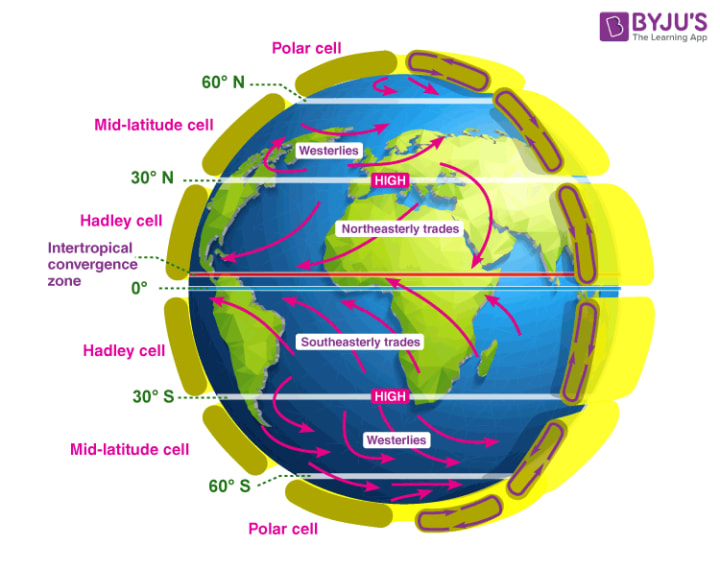A BLUE HAIKU
WIND

This haiku was inspired by the knowledge I found on the website called “BYJUS” at www.byjus.com/physics/types-of-wind/ . I found the information intriguing and exceptionally informative.
Here’s an excerpt:
“The wind is a moving air that is caused due to the differences in air pressure within our Earth’s atmosphere. Wind flows from the high air pressure area to the low air pressure area to balance the disparities of air pressure. The more significant the pressure difference, the faster the wind flows.
Classification of Wind
On earth, winds are broadly classified into three categories:
• Primary Wind
• Secondary Wind
• Tertiary Wind
This classification is based on the periodicity of occurrence and location of occurrence.
Primary Wind or Planetary Wind
Primary winds constantly blow throughout the year in a particular direction. Primary winds are also known as prevailing winds or planetary winds. Trade winds, westerlies and easterlies are different types of primary wind.
Secondary Wind or Periodic Wind
Secondary winds are winds that change their direction in different seasons. Secondary winds are also known as seasonal winds and periodic winds. Secondary winds occur in many locations throughout the world. A particular secondary wind and the underlying physical forces that drive the wind depends upon the unique geographic location. One of the most commonly recognized secondary winds is the monsoon wind.
Tertiary Wind or Local Wind
Tertiary winds blow only during a particular period of the day or year in a small area. These winds blow due to the difference in temperature and air pressure of a specific location. These winds can be of different types, like hot, cold, ice-filled, dust– rich, in accordance with local characteristics. Loo is a hot and dry local wind of the northern plains of India. Other main local winds include Mistral, Foehn, Bora, etc.
Different Types of Wind
Trade Winds
Trade winds are also known as tropical easterlies and blow from the right in the Northern hemisphere and to the left in the Southern hemisphere due to Coriolis effect and Ferrel’s law. They start blowing from the sub-tropical high-pressure areas towards the equatorial low-pressure belt. In the Northern hemisphere, they blow as northeastern trades, and in the Southern hemisphere, they blow as southeastern trades.
Watch the video and understand the principle of coriolis effect with the help of real-life demonstration.
1,51,790 views
The Westerlies
These winds are also known as Shrieking Sixties, Furious Fifties, and Roaring Forties. They blow from the subtropical high-pressure belts towards sub-polar low-pressure belts. The westerlies of the Southern hemisphere are more robust and constant than the westerlies of the Northern hemisphere.
Polar Easterlies
The Polar easterlies are cold, dry permanent winds that blow from north-east to south-west direction in the Northern Hemisphere and south-east to the north-west in the Southern Hemisphere. Easterlies blow from the high-pressure polar areas of the subpolar lows.
Monsoon Winds
A monsoon is a wind in low-latitude climates that periodically reverses direction between summer and winter. Monsoons usually flow from the land in winter and from water to the land in summer, resulting in a severe change in the temperature and precipitation patterns of the area affected by the monsoon. The temperature difference created by the Indian Ocean, Arabian Sea, Bay of Bengal and Himalayan wall forms the basis of the monsoon in the Indian subcontinent.
Land Breeze and Sea Breeze
Land Breeze is a local wind system that is characterised by winds that blow from land to sea, carrying no moisture. On the contrary, sea breezes are winds that blow from sea to land, bringing some moisture. Land Breezes are dry and warm.
Read More: Difference Between Land Breeze and Sea Breeze
Mountain and Valley Breeze
During the day, the slopes get warmed up in mountainous regions, and air flows upslope to fill the resulting gap. This wind is known as the valley breeze. During the night, the slopes get cooled, and the dense air descends into the valley as a mountain breeze.
Local Winds
The local differences in temperature and pressure produce local winds. Such winds are limited to the lowest levels of the troposphere. Some examples of local winds discussed are Loo, Bora, Chinook and Zonda.
Causes of Wind
The main cause of generation of wind is the uneven heating of two regions. Following are the examples of uneven heating we see around us:
What is uneven heating between land and sea?
Seawater gets heated more slowly as compared to land. As the temperature of the land rises, the air above it gets heated by conduction. The density of warm air is less than the surrounding environment, because of which it rises, creating a vacuum in its place. The cooler air from the sea rushes to fill the vacuum which creates a cool coastal breeze. At night, the land cools off more quickly, which creates a temperature difference between the temperature onshore and that offshore. Because of this temperature difference, again, a pressure drop is created, establishing a land breeze.

The flow of Air between Land and Sea
What is uneven heating between equator and pole?
The equatorial and tropical regions (close to the equator) get the maximum heat from the sun; hence they get hotter than the polar regions. The air surrounding this region gets heated up and rises to create a vacuum. Cooler air from the poles rushes to fill the vacuum. The wind does not flow in the north-south direction because a change in direction is caused by the rotation of the earth.

The Flow of Air between Equator and Pole
How is Wind Measured?
The wind has speed as well as direction, to measure this parameter, two different devices are used:
Anemometers
Anemometers are a common weather station instrument which is used for measuring the speed of the wind. Cup anemometer, hot wire anemometer, windmill anemometer, sonic anemometer, and laser doppler anemometer are the different types of anemometer.
Wind Vanes
Wind vanes are also known as weather vane, which is used for determining the direction of the wind."
-An excerpt from the author(s) of www.byjus.com/physics/types-of-wind/
So here's the poem:
"A BLUE HAIKU: WIND"
Through the Land and Sea
What a whispering Wind
Bountifully blowing, Blue
Copyright 2022, Rev. Nnedi Iwuchukwu, BA, M.MSC, LMT, LMI, MMP, RYT-200
About the Creator
Princess Rev. Nnedi Iwuchukwu, M.Msc., LMT, LMI, MMP, Yogi
Rev. Nnedi, is an ordained minister, licensed celebrity medical massage practitioner, instructor, dream interpreter, entrepreneur and is Roman Catholic. A PORTION OF THE TIPS AND SUBSCRIPTIONS RECEIVED, WILL BE DONATED TO VARIOUS CHARITES.






Comments
There are no comments for this story
Be the first to respond and start the conversation.